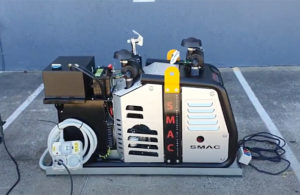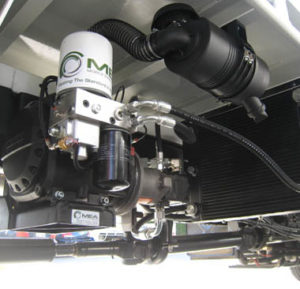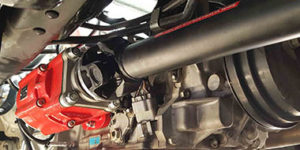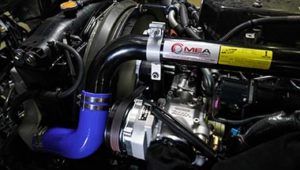Top advantages of using an Air Compressor
What is an air compressor?
An air compressor is a mechanical device that raises the air pressure to power various air tools or pneumatic machinery. It compresses air from a large volume at a relatively low pressure to a small volume at a higher pressure. This boost in air pressure allows air tools to be much more effective than conventional hand tooling or battery-powered tools. Portable air compressors are excellent for large jobs such as airbrushing, sandblasting, construction, etc.
The air compressors take ambient air through an inlet valve and trap the air within the vessel. The air is then compressed using a piston, rotary screw, or other type, releasing high-pressure air through an outlet valve or into a storage vessel. Depending on the type of compressor used, this process may be repeated many times, and the pressure further increased. Air compressors can also run continuously or intermittently and have varying degrees of complexity. Not only are air compressors used to power tools such as nail guns, sprayers, and pneumatic tools, but they can also be used for automated operations in manufacturing plants and to generate power in refineries. At the same time, bigger stationary versions are used for industrial tasks like cleaning factories and powering extensive pneumatic machinery.
Different types of Air Compressors
There are many different types of methods to compress air mechanically.
The engineering principle has defined these into two typical classes of compression.
- Positive Displacement
- Dynamic
Positive displacement covers all variations of rotary and reciprocating compressors.
- Rotary compressors can be separated into the subcategories below.
- Rotary screw compressors
- Lobe compressor
- Liquid ring compressor
- Scroll compressor
- Vane compressor
- Reciprocating compressors fail into only three subcategories.
- Single Acting
- Double Acting
- Diaphram
The Dynamic classification refers to compressors, trompe or air bubble compressors.
Two main subcategories of air compressor fall under this dynamic classification.
This is well described in the air compressor wiki Compressor. (2023, August 1). In Wikipedia. https://en.wikipedia.org/wiki/Compressor
- Centrifugal compressors
- Axial compressors
Using an Air Compressor safely
An air compressor is an excellent tool in the workshop and on mobile site applications, but taking the necessary safety measures when using one is essential. Many compressors have built-in safety features such as pressure relief valves open to release air when the pressure exceeds the maximum limit. Safety glasses should always be worn to protect your eyes from potential debris, and gloves should be worn to keep your hands safe.
Hearing protection is also highly recommended when operating an air compressor, particularly when the operator must remain close to it. Compressing air, depending on the method and drive system of the compressor, can produce harmful decibel levels or higher DB ratings that can damage your ears. Watching those working near a compressor is also imperative, as there is always a risk of injury or fatal harm. Finally, keeping an eye on the pressure gauge to ensure it does not exceed its maximum working pressure is a good idea.
In some ultra-high pressure settings, even contact with the compressed air could cause severe or life-threatening injury. In these ultra-high-pressure environments, the highest level of full-body PPE must always be worn alongside proper training and sufficient protocols. Mobile Energy Australia offers machinery and air compressor training on all product ranges during the handover of specialised equipment in conjuction with all relevant MSDS material safety data sheets and extensive owner operational documentation.
What is an air compressor used for?
An air compressor is a hugely versatile tool that is used in a variety of contexts. It is a machine that converts electrical energy, engine combustion, hydraulic or the energy from another source (PTO) power-take-off– into pressurised air. This pressurised air can then be used to power various tools, such as impact wrenches, rattle guns, venturi pumps, jackhammers, and even inflating truck tyres. Due to its versatility, air compressors are widely used in various sectors, from automotive to agricultural to construction. Some common industries require mobile compressed air sources on hand for day-to-day operation. Learn more about how to use an air compressor in our blog.
- The Mining sector.
- The compressed air is fundamental to the mobile service vehicle fleet, which uses the compressed air to perform routine and breakdown maintenance on mining machinery and plant.
- Utility maintenance industry.
- The gas, water and power networks rely on compressed air to run specialised tooling such as line boring tools, rock breakers, jackhammers, die grinders and venturi pumps. The air supply allows the specialised providers to reduce unnecessary excavation to access network faults.
- Mobile Mechanics.
- Utilise the compressed air with their pneumatic tools. These are rattle guns, die grinders, impact wrenches, blowing out filters, clearing debris from radiators and re-inflating tyres. Another commonly used tool is an air jack to lift the vehicle to gain access underneath the vehicle or remove components such as tyres, diffs and transmissions.
- The mobile tyre replacement industry.
- The tyre industry focuses more on the precise pressure of tyre inflation, ranging from tiny (PSI) pounds per square inch on small cars to larger tyres seen on tractors, semi-trailer trucks and specialised equipment, which may require 165 or higher (PSI).
- Boilermakers and industrial welding contractors.
- Boilermakers and welding contractors enhance their traditional techniques by introducing additional compressed air into the welding process. This is commonly known as air arc gouging. They also can incorporate high-pressure air to assist in cutting thick metals to ensure the temperature is steady and the intensity of the arc blows cleanly without slag created.
- Civil Construction applications.
- You may have seen the tow behind air compressors on many construction and civil fracture sites. These are common-use pneumatic supplies for other auxiliary equipment needed to complete the construction. Pneumatic pumps, called venturi pumps or transfer pumps, are used when excess water needs to be pumped out of the working area after rainfall.
- Drill rigs and Geological excavation industries.
- Drilling and geological proving rigs typically use a combination of hydraulic-powered boring drills, large amounts of water and compressed air. The compressed air can force the excess water out of the hole, like blowing a high bubble at the end of a straw. Forcing the water to the surface. It also can be used to pressure test the pipe, ensuring the hollow pipeline connections are secure and properly threaded together.
Advantages of Air compressors over other power sources
Air compressors provide a range of benefits over other power sources. Perhaps the most significant benefit is their cost savings. Air compressors are usually cheaper than other power sources and require less maintenance. They also require less manual labour since an electrical source, hydraulic pump, diesel or petrol engine, (PTO) power-take-off and an air compressor are all needed to make them run. This makes them a great option for businesses looking to reduce their environmental impact and save on costs. By reducing the overall equipment weight needed on vehicles GVM and trailers. While also decreasing the footprint or physical space taken up by larger types of equipment.
Furthermore, air compressors can be much quieter than their alternatives. Especially the electric variations of the air compressor because usually, the drive method of the compressor makes the largest DB rating or audible noise. This makes them ideal for those that operate in commercial and industrial environments where noise pollution is an issue. Finally, air compressors can be used in various applications, making them highly versatile and multi-functional. Allowing the owner or operator to use pneumatic tooling as the primary source to get the job done.
What Are the Must-Have Air Compressors Accessories?
This section explores some commonly used accessories when adapting compressed air to operate tools, equipment and machinery.
- Pressure regulators. These are arguably the most common inline accessories you could ever need on an air compressor. The pressure regulator lets the operator adjust the PSI (pounds per square inch) easily and effectively regulate the discarded compressed air to the required setting. These setting or operation requirements are typically found on the tool or equipment identification plate and instructional data sheets. Following these guidelines will ensure the longevity of the tool’s operational lifespan and reduce the risk of injury to the person operating the equipment.
- Water and dirt removal filters. Like most industries, the workspace can become dirty, wet or even contaminated at extremes. Air compressors can also suffer from air contamination, mostly dirt, water and carry-over oil caused by poor separation. These contaminants can clog or affect the equipment powered by compressed air. The industry’s best practice is always to include an elimination filter, otherwise known as a dirt and water trap. These mount after with the discharged compressed air and filter out any excess water or contaminants without restricting the pressure or flow (CFM) cubic feet per minute.
- Air hose, hose reels, airlines and coupling fittings. No matter what the compressed air application, there will be some sought of compressed air plumbing involved. These are essential for the compressed air to reach the delivery point.
- Air hoses are sized accordingly to maintain pressure over distance. Inadequate sizing can result in pressure loss (PSI) or a sharp drop in (CFM). If you were to size the air hose too small, you effectively restrict the potential output. If you sized the hose too large, you created additional space for the compression to dissipate.
- Hose reels on mobile applications provide a perfect solution for storing metres of air hose. Rather than rolling out line lengths, hose reels offer manual and automatic retractable mechanisms. Thus offering the compressed air user a simple and effective way to maintain a tidy workspace. This will reduce the hose’s manual handle and the risk of slips, trips and falls on the worksite.
- Airlines are commonly seen in stationary or factory applications. However, they can also be incorporated into mobile plants and vehicles similarly. Think of these like the air compressor version of the human circulatory system. The heart is the air compressor, and the airlines are the veins reaching all the needed locations.
- Coupling fittings. At the end of any hose must be fitting to secure the airline’s connection. In most cases, these are not fixed permanently and will require a quick connection fittings. Thus ensuring there are no leaks and forming a tight seal. The two most common mobile applications are min sup type A & B and Nitto Quick Connects. The mins-up type is commonly used on larger hoses and incorporate locking pin and blanks when not used. The Nitto style is mainly seen on hand-held tools such as tyre inflators, rattle guns and die grinders. They clip in and out using a mechanical ball-baring ring to couple on and off quickly.
- PPE is otherwise known as Personal Protective Equipment. An absolute must-have accessories are personal protective equipment when using air compressors. They include safety glasses, gloves, dust masks, breathing air apparatus, high visibility clothing, hearing protection (ear plugs & ear muffs), safety boots, and long sleeve shirts & pants. All Australian workplaces should adhere to all safety precautions when using air compressors, not just because of regulations in place from the government but also as a minimum best practice when operating any potentially dangerous machinery.
What are the different types of air compressors we have to offer?
Mobile Energy Australia offers the highest quality of Australian manufactured air compressors. The MEA range specialises in portable compressors, vehicle-mounted compressors, hydraulically powered air compressors, (PTO) power-take-off air compressors and all types of rotary screw air compressors for specialised applications.
These industrial-grade units have been categorised online into the following groups.
- Diesel engine-powered air compressors.
- The SMAC range of rotary screw compressors offers exceptional performance and reliability. This compressor’s sleek tubular design and compact nature provide an exceptional power-to-weight ratio machine. Highly regarded throughout Australia for its robust quality and well-supported industry-leading components. SMAC air compressors are an essential piece of equipment for most mobile industrial applications. The SMAC compressor range can be found on Mining service vehicles, Australia’s largest mobile tyre-changing fleets, City council maintenance trucks and mobile heavy diesel mechanics ute trays Australia-wide.

- The SMARTPACK 35 range of fully portable rotary screw air compressors offer a high-quality entry-level mobile compressor. Best suited for mobile mechanics and portable air compressor applications where the compressors can be moved around freely to reduce the distance to the work area. The belt-driven compressors are easily accessible and allow for easy serviceability without compromising on the performance and quality of the compressed air. For more information on the application of small diesel compressors, visit our blog.
- The SMAC range of rotary screw compressors offers exceptional performance and reliability. This compressor’s sleek tubular design and compact nature provide an exceptional power-to-weight ratio machine. Highly regarded throughout Australia for its robust quality and well-supported industry-leading components. SMAC air compressors are an essential piece of equipment for most mobile industrial applications. The SMAC compressor range can be found on Mining service vehicles, Australia’s largest mobile tyre-changing fleets, City council maintenance trucks and mobile heavy diesel mechanics ute trays Australia-wide.
- Petrol engine-powered air compressors.
- The SMARTPACK 70-P & 35-P also is available in petrol engine-powered models. The petrol-style combustion engine is commonly used in industries where all equipment is fueled with petrol. To avoid carrying two types of fuel and also fuel contamination risks. These compressors are still highly powerful and can produce large (CFM) and (PSI) free air delivery when needed. Typically starting at a lower price due to the tier of the engine supplied. They maintain their usability and affordability for consumers.
- Hydraulically driven air compressors.
- Mobile Energy Australia has been engineering hydraulic-powered air compressors for over 20 years. The SMARTPACK H (hydraulic) range of air compressors can produce from 20 CFM up to 400 CFM. Hydraulic compressors can be found on large service trucks, excavators, drill rigs, and mobile plants or connected to hydraulic power packs. Anywhere that has a hydraulic system can incorporate the MEA range of hydraulic air compressors. The two major requirements to install the hydraulic compressor are sufficient hydraulic flow and pressure, a power supply for the control box and a thermo fan (12v or 24v) and the physical space to mount the unit or its components. The system works simply by providing the correct hydraulic requirements to the motor (Gear or Piston), which drives the screws to create compressed air. The air is regulated using an intake valve and pneumatic blowdown. Forcing the solenoid to engage in bypassing the motor while at maximin pressure.

- Mobile Energy Australia has been engineering hydraulic-powered air compressors for over 20 years. The SMARTPACK H (hydraulic) range of air compressors can produce from 20 CFM up to 400 CFM. Hydraulic compressors can be found on large service trucks, excavators, drill rigs, and mobile plants or connected to hydraulic power packs. Anywhere that has a hydraulic system can incorporate the MEA range of hydraulic air compressors. The two major requirements to install the hydraulic compressor are sufficient hydraulic flow and pressure, a power supply for the control box and a thermo fan (12v or 24v) and the physical space to mount the unit or its components. The system works simply by providing the correct hydraulic requirements to the motor (Gear or Piston), which drives the screws to create compressed air. The air is regulated using an intake valve and pneumatic blowdown. Forcing the solenoid to engage in bypassing the motor while at maximin pressure.
- Electric motor-powered air compressors.
- Mobile Energy Australia has specifically designed electric or 12/24 volt air compressors for working vans, agriculture applications and the off-road 4×4 serious market. These compact electric piston compressors surpass all the hobbyists and other smaller cheap systems available. They have been engineered using higher-grade components designed for longer working life spans and ease of maintenance. The BATTCOM electric range is nearly completely silent during operation and has very little AMP/hr draw or performance drop in the duty cycle. More information can be found about why you need a compressor for off-road; visit the MEA blog.
- Underdeck (PTO) power-take-off vehicle transmission air compressors.
- MEA has perfected the art of power-take-off transmission in medium to large Australian trucks. The underdeck air compressor is the highest-powered integrated air compressor for mobile working vehicles. Capable of producing 85 to 175 CFM at 100 to 150 PSI. These air compressors are for serious applications onsite. Typically, utilised when line boring, pipe relining, jackhammering road surfaces and pressuring pipe systems for leak detection. The advantage of PTO-style air compressors is they can never be lost or misplaced, stolen or require to be towed behind a truck. All the working components are mounted underneath the truck’s body, and components are placed between the chassis rails. Thus making the entire system of this high output hidden and much lighter on the payload (GVM) of the truck. Operation is simple as the driver of the vehicle parks, engages the hand break, presses the PTO button on the dash, and the vehicle engages the PTO and idles accordingly to the air required.

- MEA has perfected the art of power-take-off transmission in medium to large Australian trucks. The underdeck air compressor is the highest-powered integrated air compressor for mobile working vehicles. Capable of producing 85 to 175 CFM at 100 to 150 PSI. These air compressors are for serious applications onsite. Typically, utilised when line boring, pipe relining, jackhammering road surfaces and pressuring pipe systems for leak detection. The advantage of PTO-style air compressors is they can never be lost or misplaced, stolen or require to be towed behind a truck. All the working components are mounted underneath the truck’s body, and components are placed between the chassis rails. Thus making the entire system of this high output hidden and much lighter on the payload (GVM) of the truck. Operation is simple as the driver of the vehicle parks, engages the hand break, presses the PTO button on the dash, and the vehicle engages the PTO and idles accordingly to the air required.
- Under bonnet (PTO) power-take-off belt driven from the vehicle’s engine.
- Trade-marked by VMAC underhood air compressors. Drive directly off the engine’s main pulley system. Arguably the lightest power-to-weight high-volume compressor on the market. The engine-driven style power take-off is the market-leading technology providing reliable portable compressed air. Mobile Energy Australia has worked closely to bring this internationally acclaimed system to the Australian market. Engineering the custom design brackets with another leading Australian manufacturer RAMAIR. Thus allowing all the commonly sourced work trucks in Australia to have this quality VMAC system implemented. MEA has successfully installed hundreds of the VMAC VR70 & VR40 air compressors on hard-working trucks. The VR70 suits ISUZU, HINO, FUSO, MISTSUBISHI and FORD Rangers.

- Trade-marked by VMAC underhood air compressors. Drive directly off the engine’s main pulley system. Arguably the lightest power-to-weight high-volume compressor on the market. The engine-driven style power take-off is the market-leading technology providing reliable portable compressed air. Mobile Energy Australia has worked closely to bring this internationally acclaimed system to the Australian market. Engineering the custom design brackets with another leading Australian manufacturer RAMAIR. Thus allowing all the commonly sourced work trucks in Australia to have this quality VMAC system implemented. MEA has successfully installed hundreds of the VMAC VR70 & VR40 air compressors on hard-working trucks. The VR70 suits ISUZU, HINO, FUSO, MISTSUBISHI and FORD Rangers.
- Imported high-quality rotary screw & piston air compressors.
- From its earliest inception, Mobile Energy Australia focused on bringing market-leading air compressor technologies to the Australian market. Over that time, MEA built great working relationships with many international supply chains. Many of these high-quality international air compressor manufacturers’ equipment is still heavily sort after and still well supported by Mobile Energy Australia for new machines and vital spare parts.
Summary of benefits of using an Air Compressor
An air compressor is a wonderful technology that benefits companies and professional contract workers. First and foremost, they allow you to quickly and efficiently complete tasks with minimal effort. Additionally, they are incredibly useful in providing power for several construction, automotive and mechanical tasks where powerful tools are necessary.
Some major advantages of owning an air compressor include increased efficiency, improved safety, the ability to power various tools, and superior convenience. Air compressors are essential for many tasks, from painting, filling car tyres, home improvements, and powering various impact and cutting tools. Therefore, investing in an air compressor might be your best option if you’re looking for a reliable and efficient tool. And if you need assistance finding the right air compressors for your application Mobile Energy Australia is here to help. For more information or assistance buying portable air compressors, call or submit an online enquiry form.
